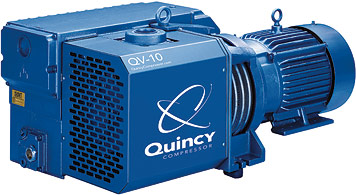What Is A Medical Vacuum Pump?
To answer the question of what a medical vacuum pump is, we first have to answer the question of what a regular vacuum pump is.
A vacuum pump is an industrial device that removes gases and liquids from enclosed spaces. The purpose of this is to create a vacuum or to deliver a steady stream of gas. Hence why the equipment is called a vacuum pump.
Many times people refer to a compressor and a pump as the same thing. As you well know, this isn’t really true. A pump moves liquid or gas from one place to another. A compressor, on the other hand, creates a smaller volume out of gas, then moves it somewhere else.
How Are Medical Vacuum Pumps Different?
Medical vacuum pumps keep medical professionals safe from potentially harmful substances. These vacuum pumps are used within hospitals, vet clinics, and medical clinics at large. Vacuum Pumps can be used for applications such as:
- Draining wounds
- Lung Draining
- Collection and removal of fluids
- Wood Draining
- Tube Cleaning
Much like medical-grade air compressors, medical vacuum pumps must be NFPA99 compliant. This type of compliance dictates that contaminants never come into contact with patients seeking medical care.
It is important to used NFPA99 equipment and find specialists who are able to correctly service these systems. Especially if no one within your maintenance team knows how to service these machines themselves.
Types of Medical Vacuum Pumps
Dry Claw Pump
Claw vacuum pumps have two rotors that continually rotate. While rotating, these rotors never come into contact with each other. The rotation moves gas along from the suction side to the pressure side creating pressure. This pressure is what ultimately compresses the gas. Cool air is brought into the compression housing to reduce the temperature before it leaves the pump.

Rotary Vane Pumps
Rotary Vane Pumps work using positive displacement. The pump forces a fixed amount of gas from the inlet pressure section to its discharge. These pumps have a series of vanes that are mounted to a rotor that turns within a cavity. With each vane rotation, centrifugal force extends the vanes from their slots creating compression cells.
There are two that are considered medical vacuum pumps:
- Dry Rotary Vane Pump
- Oil Sealed Rotary Vane

Contact Us
Choosing the right vacuum pump for your application can be difficult. While we have a blog post on how to choose the right pump for you, we still advise that you seek the help of a specialist to make sure that your pump will do everything it needs to.
If you have more questions on which medical vacuum pump you should be using, please contact us by email or phone. We’d be happy to help you with your selection!
-
President, JHFOSTER Clark Oster is a seasoned expert in compressed air systems with over a decade of experience, currently serving as President of JHFOSTER, where he has held key leadership roles. With a background at Ingersoll Rand and expertise as a Robotics Engineer, Clark holds an MBA in Finance from the University of Minnesota – Carlson School of Management and dual bachelor’s degrees in mechanical engineering and economics from the University of Wisconsin-Madison. Combining technical expertise and strategic leadership, Clark drives innovative solutions and business success.
View all posts
